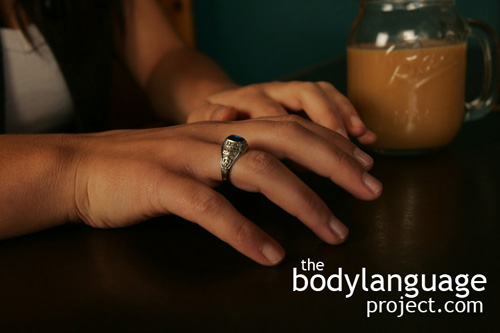Body Language of Tapping The Fingers or Metronomic Signals

 Cue: Tapping The Fingers or Metronomic Signals.
Cue: Tapping The Fingers or Metronomic Signals.
Synonym(s): Metronomic Signals, Finger Tapping, Foot Tapping, Pencil Tapping, Keyboard Tapping, Mouth Tapping, Lip Tapping, Head Tapping, Drumming.
Description: Tapping or drumming of the feet, fingers, or with the help objects such as pens.
In One Sentence: Metronomic signals show a desire to release extra energy, that a person is anxious, or that thought is taking place.
How To Use it: So long as metronomic signals are not loud or disruptive, they may be useful in telling others that you are in the process of coming up with a solution to a problem. Repetitive actions may also help prime the brain toward a solution by putting the body into motion. In other cases, the release of extra energy can help relax the mind and produce a tactile outlet. Tapping the fingers or toes may also tell others that you need some time to think and shouldn’t be bothered, thus buying some time.
Generally, however, metronomic signals are to be avoided as they signal that one is struggling to process information. One should certainly avoid the signals when they may be construed as indicating boredom – unless one actually wishes to send that signal.
Context: General.
Verbal Translation: a) “I’m bored. I’m kicking my feet and tapping my fingers to release some of my pent up energy. Escaping the situation is not practical.” b) “I’m bumping my feet up and down because I need something to do as my anxiety grows. c) “I’m tapping my pen against my lips in effort to keep my energy up to help me find the answer to my problem.”
Variant: See Foot Fidgeting.
Cue In Action: a) The lecture dragged on and on. All he wanted to do was get out of there and enjoy the weekend. His foot bumped up and down. b) On his first date, his foot bounced up and down indicating that he felt a little unsettled. c) He knew the answer, but it wasn’t coming to him. He tapped the pen against his mouth as he worked through his thoughts.
Meaning and/or Motivation: Tapping has three possible main root causes. It can indicate a) boredom, b) anxiety or that c) thought is taking place.
Repetitive tapping is often a sign of boredom. It can include tapping the toes, swinging the feet with one crossed over the other, or drumming the fingers on the table. In a larger context, tapping is a form of energy displacement where the body shows its desire to burn off what it has in excess as it deals with a situation that does not permit one to leave.
The hands and feet are key places to verify anxiety and will be the usual suspects in betraying emotions. They move easily and freely from the rest of the body and can be used to burn energy and release stress anxiety without requiring the body to move large distances. Because they can be moved independent of the body, they also tend to leak information more readily. Therefore, to read anxiety, carefully watch for tapping toes or fingers. Likewise, watch for feet that move frequently or never seem to find a comfortable position as well as any other repetitive behaviours. Foot movements will show more restraint than hand movements especially if someone is trying to hide fear from others.
In other cases, repetitive motions are an indication of a persons desire to motivate themselves. When someone is trying to come up with a solution, we normally see them tap their head with their fingertips or bring their fingertips to their lips. They may also be seen tapping a pencil or pen against their teeth or lips. When the context is appropriate expect tapping to show that a person is trying to jump start their thought process. The tapping is a way for a person to remain active and keep the blood flowing and energy up, as they fight to come up with a solution. This cue is common in the examination room.
Cue Cluster: Anxiety is often accompanied by looking away or becoming distracted, avoiding eye contact, rubbing the hands together, pinching an eyelid, smoothing clothing, rotating a wedding ring, nail-biting, or sucking a finger or pen. These all indicate a hidden thought linked to anxiety.
Boredom is often coupled with sitting slumped over with a glazed look on a person’s face coupled with an staring blankly at the floor or a spot on the wall. People also signal boredom by fidgeting, supporting the head on the hand, leaning against walls or tables, slouching backwards, letting the eyes wonder, gazing into the distance, sighing heavily, yawning, crossing and re-crossing the arms and legs, fiddling with pens, eyeglasses or papers, doodling, pointing the body away from the speaker, shifting weight, moving the head from side to side, rolling the eyes, stretching, and picking at the fingernails.
Tapping as a motivating gesture is indicated primarily through context, such as when writing an examination or while contemplating a move in chess.
Body Language Category: Auto contact or self touching, Boredom body language, Displacement behaviour, Energy Displacement, Metronomic signals, Pensive displays, Self-motivating gestures.
Resources:
Almerigogna, Jehanne; James Ost; Lucy Akehurst and Mike Fluck. How Interviewers’ Nonverbal Behaviors Can Affect Children’s Perceptions And Suggestibility. Journal of Experimental Child Psychology. 2008. 100:17-39.
http://bodylanguageproject.com/articles/get-children-tell-truth-using-body-language/
Da Silva, Felipe N. ; Irani, Farzin ; Richard, Jan ; Brensinger, Colleen M. ; Bilker, Warren B. ; Gur, Raquel E. ; Gur, Ruben C. More than just tapping: Index finger-tapping measures procedural learning in schizophrenia. Schizophrenia Research. 2012. 137(1-3): 234-240.
Doody, John ; Bull, Peter. Asperger’s Syndrome and the Decoding of Boredom, Interest, and Disagreement from Body Posture. Journal of Nonverbal Behavior. 2011. 35(2): 87-100.
Dube, Ashlynn ; Marjanne Kameka ; Stacy M. Lopresti-Goodman. Stereotypical Behaviors in Chimpanzees Rescued from the African Bushmeat and Pet Trade. Behavioral Sciences. 2012. 3(1): 1-20.
Farley, James; Risko, Evan F; Kingstone, Alan. Everyday Attention And Lecture Retention: The Effects Of Time, Fidgeting, And Mind Wandering. Frontiers In Psychology, 2013; 4: 619
http://bodylanguageproject.com/articles/mind-wandering-fidgeting-and-attention/
Gregersen, Tammy S. Nonverbal Cues: Clues to the Detection of Foreign Language Anxiety. Foreign Language Annals. 2005. 38(3): 388-400
http://bodylanguageproject.com/articles/what-anxious-learners-can-tell-us-about-anxious-body-language-how-to-read-nonverbal-behavior/
Hatz, Jessica L. and Martin J. Bourgeois. Anger as a Cue to Truthfulness. Journal of Experimental Social Psychology. 2010. 46: 680-683.
http://bodylanguageproject.com/articles/anger-nonverbal-cue-truth-telling/
Hall, Jeffrey A. and Chong Xing. The Verbal and Nonverbal Correlates of the Five Flirting Styles. Journal of Nonverbal Behavior. 2015. 39:41–68. DOI 10.1007/s10919-014-0199-8
http://bodylanguageproject.com/articles/first-12-minutes-flirting-using-nonverbal-communication-study-reveals-26-body-language-cues-attraction/
Karin Roelofs; Muriel A. Hagenaars; and John Stins. Facing Freeze: Social Threat Induces Bodily Freeze in Humans. Psychological Science. 2010 21(11): 1575-1581.
http://bodylanguageproject.com/articles/angry-faces-elicit-freeze-response-in-people-research/
Kirkland, Rena A. ; Peterson, Eric ; Baker, Crystal A. ; Miller, Stephanie ; Pulos, Steven. Meta-analysis reveals adult female superiority in “Reading the Mind in the Eyes Test”.(Report). North American Journal of Psychology. 2013. 15(1): 12.
Katza, Carmit; Irit Hershkowitz; Lindsay C. Malloya; Michael E. Lamba; Armita Atabakia and Sabine Spindlera. Non-Verbal Behavior of Children Who Disclose or do not Disclose Child Abuse in Investigative Interviews. Child Abuse & Neglect. 2012. 36: 12-20.
http://bodylanguageproject.com/articles/reading-nonverbal-behaviour-child-abuse-cases-encourage-children-divulge-information-truth-telling
Leanne ten Brinke; Dayna Stimson and Dana R. Carney. Some Evidence For Unconscious Lie Detection. Published online before print March 21, 2014, doi: 10.1177/0956797614524421.
http://bodylanguageproject.com/articles/to-spot-a-liar-trust-your-gut-not-your-eyes/
Leete, Esso. How I Perceive and Manage My Illness. Schizophrenia Bulletin. 1989. 15(2): 197-200.
Mason, G.J. Stereotypies and suffering. Behavioural Processes. 1991. 25(2): 103-115.
Mendez, Mario F. ; Mirea, Adrian. Adult head-banging and stereotypic movement disorders. Movement Disorders. 1998. 13(5): 825-828.
Newman, Sharlene ; Soylu, Firat. The impact of finger counting habits on arithmetic in adults and children. Psychological Research. 2014 78(4): 549-556.
Newton, Ashley M ; De Villiers, Jill G. Thinking while talking: adults fail nonverbal false-belief reasoning. Psychological science. 2007. 18(7): 574-9.
Pecenka, Nadine ; Keller, Peter E.. The role of temporal prediction abilities in interpersonal sensorimotor synchronization.(RESEARCH ARTICLE)(Report). Experimental Brain Research. 2011 211(3-4): 505(11).
Pederson, David R. Davidson, Park O. (editor). The soothing effect of rocking as determined by the direction and frequency of movement. Canadian Journal of Behavioural Science/Revue canadienne des Sciences du comportement. 1975. 7(3): 237-243.
Perkins, M. ; Wolkind, S. N. Asperger’s syndrome: who is being abused? Archives of Disease in Childhood. 1991. 66(6): 693(3)
Repp, Bruno ; Su, Yi-Huang. Sensorimotor synchronization: A review of recent research (2006–2012). Psychonomic Bulletin & Review. 2013 20(3): 403-452.
Rothman, Naomi B. Steering Sheep: How Expressed Emotional Ambivalence Elicits Dominance in Interdependent Decision Making Contexts. Organizational Behavior and Human Decision Processes. 2011. 116: 66-82.
http://bodylanguageproject.com/articles/ambivalent-facial-expression-form-dominance-study/
Shimooka, Yukiko ; Nakagawa, Naofumi. Functions of an unreported “rocking-embrace” gesture between female Japanese Macaques ( Macaca fuscata ) in Kinkazan Island, Japan. Primates. 2014. 55(2): 327-335.
Sturman, Edward D. Invluntary Subordination and Its Relation to Personality, Mood,
and Submissive Behavior. Psychological Assessment. 2011. 23(1): 262-276 DOI: 10.1037/a0021499
http://bodylanguageproject.com/articles/nonverbal-submission-men-women-depression-critical-examination-use-disuse-submission/
Seli, Paul; Jonathan S. A. Carriere; David R. Thomson; James Allan Cheyne, Kaylena A. Ehgoetz Martens, and Daniel Smilek. Restless Mind, Restless Body Journal of Experimental Psychology: Learning, Memory, and Cognition. American Psychological Association. 2014. 40(3): 660-668. 0278-7393/14/$12.00 DOI: 10.1037/a0035260
http://bodylanguageproject.com/articles/fidgeting-body-language-really-mean-fidget-bored-mentally-taxed/
Slepian, Michael L. ; Ambady, Nalini. Fluid Movement and Creativity. Journal of Experimental Psychology: General. 2012. 141(4): 625-629.
Van Der Zee, Sophie; Ronald Poppe; Paul J. Taylor; and Ross Anderson. To Freeze or Not to Freeze A Motion-Capture Approach to Detecting Deceit.
http://bodylanguageproject.com/articles/detect-lies-whole-body-nonverbals-new-lie-detector-successful-using-body-language-70/
Wolff, Sula. Childhood autism: its diagnosis, nature, and treatment. Archives of Disease in Childhood. 1991. 66(6): 737(5).







